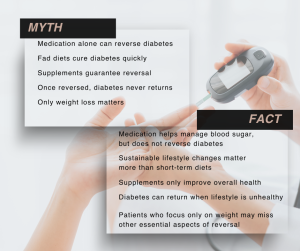- Open:Weekdays: 8:30 am – 5:30 pm, Saturdays: 9:00 am-2:00 pm
- Email: info@youdrugmart.com
Reverse Type 2 Diabetes is a phrase that sparks both hope and confusion. Many people hear stories of miraculous recoveries and quick fixes. Others feel overwhelmed by conflicting advice and misleading claims. Therefore, it is important to separate science-backed facts from myths. This blog explores what reversing Type 2 Diabetes really means, what is possible, and what is simply not true.
Type 2 Diabetes is a chronic condition that affects how the body processes blood sugar. In this condition, the body becomes resistant to insulin, and the pancreas cannot produce enough insulin to keep blood sugar levels stable. As a result, glucose builds up in the bloodstream, leading to serious health problems.
The disease develops gradually and is often linked to lifestyle factors such as poor diet, lack of exercise, and obesity. However, genetics also play a role, making some people more vulnerable. Because of its slow progression, many people live with Type 2 Diabetes for years before diagnosis.
Complications include heart disease, kidney damage, nerve problems, and vision loss. Therefore, managing blood sugar is critical to prevent long-term harm. Doctors often prescribe medication, lifestyle changes, and sometimes insulin therapy. Yet, the question remains: can we actually reverse Type 2 Diabetes?
Scientists and doctors agree that reversing Type 2 Diabetes is possible in some cases. However, reversal does not mean a permanent cure. Instead, it means achieving normal blood sugar levels without medication for a sustained period.
Lifestyle changes play the most important role. Weight loss, healthy eating, and regular exercise can improve insulin sensitivity. As a result, many patients see their blood sugar return to normal ranges. Clinical studies show that significant weight loss, especially through calorie restriction or bariatric surgery, can lead to remission.
Nevertheless, reversal is not guaranteed for everyone. Genetics, age, and the duration of diabetes all influence outcomes. Therefore, while some patients achieve remission, others may only improve their condition without full reversal. The key is understanding that reversal is possible but not universal.

Many myths surround the idea of reversing Type 2 Diabetes. These myths often mislead patients and create false expectations. Let’s examine five common myths and bust them with science-backed facts.
It is possible to reverse Type 2 Diabetes in some patients. Clinical studies confirm that remission can occur through lifestyle changes and medical interventions. Patients who lose significant weight and maintain healthy habits often achieve normal blood sugar levels.
However, it is a lie to claim that reversal is easy or guaranteed. No pill, supplement, or quick diet can cure diabetes. Reversal requires effort, patience, and long-term commitment. Moreover, not everyone will achieve remission, even with strict lifestyle changes.
Therefore, patients should focus on realistic goals. Improving blood sugar control, reducing complications, and enhancing quality of life are valuable outcomes. Even if full reversal does not occur, these improvements make a significant difference.
Patients who want to reverse Type 2 Diabetes should focus on proven strategies rather than popular diabetes myths.
Each of these steps contributes to better blood sugar control. Together, they create the foundation for possible reversal.
By separating facts from lies, patients can make informed decisions. Reverse Type 2 Diabetes is not a myth, but it is not a miracle either. It is a journey that requires effort, guidance, and hope.
